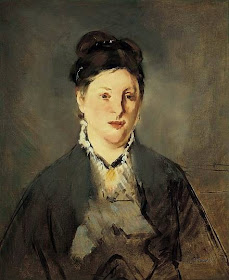 |
| John Atkinson Grimshaw |
As anyone who reads my words very often might guess, I seldom praise the Victorian Era. It was too pretty, too pretentious, too prudish, too precious, and insofar as its art was concerned, too preoccupied with the Pre-Raphaelites. For those reasons I was nothing less than
stunned when I came upon the paintings of the English Victorian artist, John Atkinson Grimshaw. I not only
like his work, it wouldn't be going too far to say I
love it. In writing about the efforts of any artist I try not to gush, but this man's Northern English nocturnes are nothing less that
gorgeous. And so long as he sticks to his "night" job, his art is among the best produced by
any British artist during the 19th century. Yes, he does have a disturbing penchant for delving into "Tinkerbellish" pixies from time to time and his sedate, Victorian ladies in all their buttoned up fineries are as prim and proper as the best (or worst) such images produced by any of a hundred or more British painters of his time. But thankfully, neither such indulgences dominate his oeuvre and in their paucity become little more than divergent curiosities.
 |
| A Dead Linnet, 1862, John Atkinson Grimshaw |
 |
| March Morning, 1867, John Atkinson Grimshaw |
John Atkinson Grimshaw was born in 1836 in Leeds (North-central England). From all indications, he seems to have been self-taught, there being no record of
any level of higher education in
any area of study. At the age of twenty he married his cousin and went to work as a clerk for the Great Northern Railroad. Then, in 1861 he shocked and dismayed his parents by literally quitting his "day job" to become an artist. Grimshaw began displaying his work a year later, mostly fruit, flowers and birds (dead ones at that, above, which might explain his slow start in art). In any case, his output during the 1860s was typical amateurish stuff. His
March Morning (left)
from 1867 would suggest he was on the right track, he simply needed to get up a few hours earlier. However, by 1870, Grimshaw was so successful he was able to rent a second home in Scarborough. There's no record as to how many children he and his wife produced, but
four of them eventually became artists.
 |
| Liverpool from Wapping, 1875, John Atkinson Grimshaw |
 |
Blackman Street, 1885,
John Atkinson Grimshaw |
Though he seems not to have studied art in the academic sense, there's no denying that Grimshaw was influenced by the Pre-Raphaelites. But Grimshaw could in no way be termed a Pre-Raphaelite. First of all, he wasn't that good. His technique lacks the endless refinement of the brotherhood, and painting in the North of England, it's doubtful
William Holman Hunt,
John Everett Millais or
Dante Gabriel Rossetti ever so much as even
heard of him. In any case, none of them would ever go down in the annuls of art history as landscape painters, much less of the nocturnal variety. One artist who
did paint nocturnal landscapes and was virtually the same age as Grimshaw, was the American expatriate working in England at the time,
James McNeill Whistler. Moreover, they seem to have been friends. Whistler painted in an Impressionist style. Grimshaw's style was anything but, about as neat, clean, and sharply focused as could be imagined. After seeing Grimshaw's work, Whistler gave up painting nocturnes.
 |
| Boar Lane, Leeds, 1881, John Atkinson Grimshaw |
 |
A moonlit Lane, 1873,
John Atkinson Grimshaw |
Grimshaw was a master at moonlighting. Although he probably did some of that while still working for the railroad, in this case I'm talking about
using the moon to light his works, which must have limited somewhat the nights of the month during which he could paint. Even a full moon doesn't provide much light. Grimshaw's real talent was in making the most of such limited light, no doubt exaggerating it somewhat, but not so much as to make his doing so noticeable beyond the dramatic effects he captured. However, not all of Grimshaw's night scenes were lit by the moon. Many appear to have been twilights or sunsets (and sunrises). In some of my favorites, he also relies on the ghostly glow of London gaslights as well.
 |
| Summer, 1890s, John Atkinson Grimshaw |
 |
Snowbound, 1883,
John Atkinson Grimshaw |
I mentioned earlier Grimshaw's more traditional Victorian works, his
Summer (above) from around 1890 (possibly one of his daughters) suggests an understanding and appreciation for Impressionism not seen in his nocturnal scenes, or, indeed, his earlier portraits such as 1883
Snowbound (left). In this case he paints a much more refined image, akin to his earlier Pre-Raphaelite yearnings. Even though his female figures are typically and tolerably Victorian, Grimshaw's pixie paintings (he referred to them as spirits) are downright insipid. His
Spirit of the Night from 1879 (below) could well have been an inspiration for J.M. Barrie (author of
Peter Pan).
 |
Spirit of the Night (detail), 1879,
John Atkinson Grimshaw |
Although it's unlikely, given the lighting conditions, that Grimshaw was an in plein air painter, one can't master the mysteries and beauties of the nighttime by spending those hours secluded in the comforts of a studio. There are precious few letters or records as to John Atkinson Grimshaw's life and working routine (he was an artist, not a diarist) but all those night prowling the streets of Leeds and Liverpool in the dank dampness of the British mists proved not to be advantageous to the man's health. He died in 1893 of Tuberculosis at the age of 53.
 |
Two Thousand Years Ago, 1878, John Atkinson Grimshaw.
At times, Grimshaw showed signs of wishing he could be a Pre-Raphaelite. |

















































